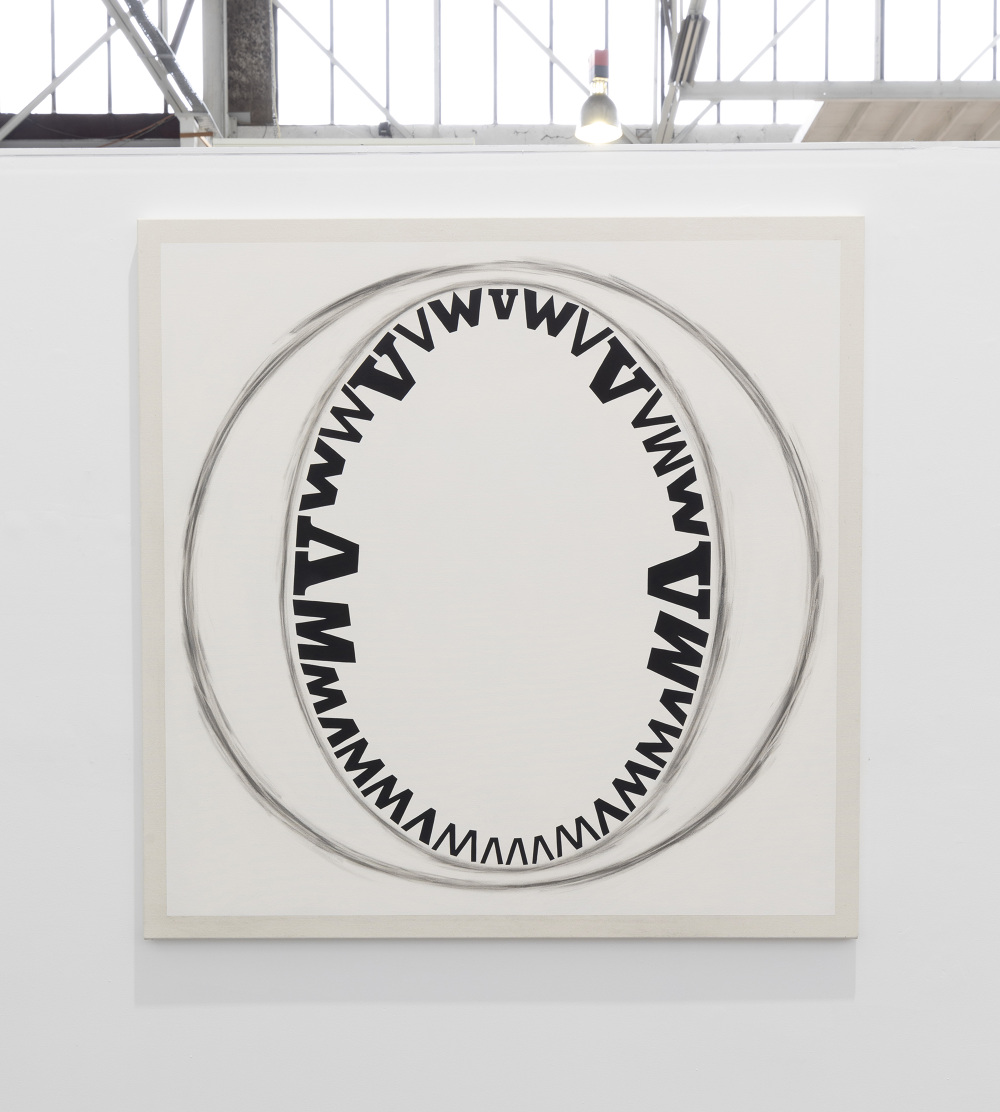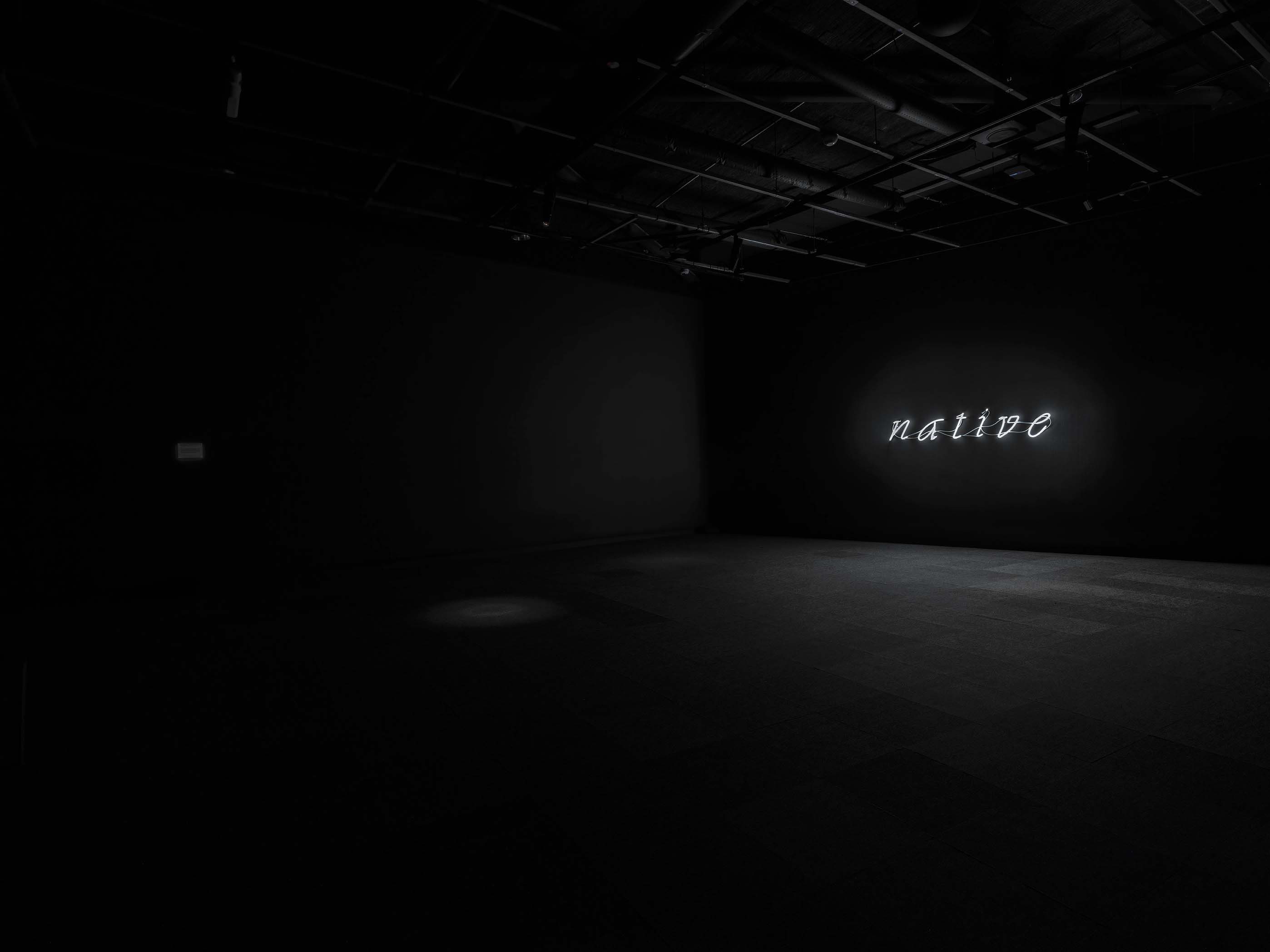Darcey Bella Arnold
. . . a page presents a painting that trembles on a line.

Darcey Bella Arnold
. . . a page presents a painting that trembles on a line.
Notes to Vag Dens (2024) is a painting, a concrete poem and an historical narrative created through a visual dialogue. A canvas that pays homage to the page presents letters not words that speak to the feminine and salute the central core imagery of second wave feminism. Darcey Bella Arnold creates an intergenerational dialogue with the ‘original’ Vag Dens painted by Vivienne Binns in 1967 and exhibited at Watters Gallery in Sydney that year.
 Arnold, Notes to Vag Dens 2024, 150-x-150cm acrylic and charcoal on cotton duck. Photography credit Jessica-Maurer
Arnold, Notes to Vag Dens 2024, 150-x-150cm acrylic and charcoal on cotton duck. Photography credit Jessica-Maurer
Vag Dens is legendary in the history of feminist art in Australia. Male critics in the 1960s ignored Vivienne Binns’ Pop Art credentials, her links to the then avant-garde through associations with the Annandale Imitation Realists, and lampooned her work as a gross and ugly representation of the horror of the female body. In contrast, Vag Dens became an icon of feminist art history in Australia because it celebrated the female body and sexuality. From its inception this painting is in language, already in history and art criticism.
Binns’ painting depicts a toothed vagina that appears to be imbedded in the profile of a woman’s face. It is surrounded by colourful penis-like mushrooms each breaching the multi-layered membranes of the orifice. A purple, heart shape extends from the top of the vagina showing ovaries, fallopian tubes and blood vessels swirling in evanescent colours, reminiscent of a graphic design of a hallucinogenic trip. It was painted at the apex of sexual liberation and embedded in the liberation politics of its time. The work along with its cousins from 1966 – Phallic Monument and Suggon – is now in the collection of the National Gallery of Australia.
A lot has happened in feminist theory since the late 1960s but the central core/vagina image is still a dangerous icon to play with. In its form it endorses the power of the female body to conceive and thus create the next generation. The vagina dentata – the toothed vagina – is a form that recognises the fear the image transmits for patriarchal masculinity. However, the image is perceived diversly amongst different cultures and demographics. It is ancient rather than modern, dating back to Greek mythology, yet contemporary artists and feminists engaging with the imagery still unsettle social and political boundaries. In patriarchies the image appears to have the power of sorcery inducing abject horror in some people.
Darcey Bella Arnold enters into this dialogue across histories to pay homage to a visionary elder and to open a conceptual conversation. Whereas Binns, operating as a visual arsonist inside the language of Pop Art, depicts a utopian promise of sexual liberation contingent on the recognition of woman, Arnold underlines the role that language plays inscribing gender by creating a vagina dentata with letters on a page that have been enhanced through the medium of painting.
Recognising the blurring of mediums in this work enhances a conceptual understanding of the painting. The image itself is historically and politically dense but the rendering appears simple, almost minimalist by design. Arnold painstakingly reproduces Letraset letters onto a seemingly raw canvas. The letters contain an ovoid shape marked out in repetitions of upper and lower-case Ms, Ws and Vs. The letters imitate teeth, they threaten violence in the stillness of the void as they attempt to eat it – exposing the violence within language and its terror of the void. The nothingness at the heart of being. This is a powerful image in itself but Arnold wants to say more in this instance so she contains the image with two hand drawn charcoal ovoid gestures that suggest movement. In this way the letters are given a kind of visual agency – they might take flight, leave the page, the canvas. It is as if Arnold wants to tell us that despite history, language is actually on the move, things are changing, language has the capacity to shape-shift ideas.
The words we speak and write inscribe us, but we also inscribe it. Each year dictionaries and data bases add more words as their researchers and artificial intelligences listen to the idiom of language on the ground. Language may speak the subject (Lacan), we may be thrown into language (Heidegger) and we might accept that we are always already written (Althusser) but we are also inscribing the language that we activate through speech. It’s a two-way street. And nowhere is this more apparent than in the volatile and shape-shifting language of gender.
Darcey Bella Arnold understands the power of language, speech and interpretation. She explores letters, iterations, translations, diversities. In Notes to Vag Dens she focusses on gender and the female body but her investigative probing of language spans various fields.
Notes
2. Deborah Clark, ‘The Painting of Vivienne Binns’, Vivienne Binns, Tasmanian Museum and Art Gallery, Hobart: TMAG, 2006, p. 10. See also Judy Chicago, Through the Flower: My Struggle as a Woman Artist, New York: Anchor/Doubleday, 1977 (first published 1975).
3. See Richard Haese, Permanent Revolution: Mike Brown and the Australian Avant-Garde 1953-1997, Carlton: The Miegunyah Press, an imprint of Melbourne University Publishing, 2011, p. 136 and original press reviews re-published in full in Refractory Girl, no. 8, September 1975, p. 16.
4. In western philosophy this is explored by the existentialist Jean Paul Sartre in Being and Nothingness (1943). In Eastern philosophy the concept of nothing, the void and emptiness are examined in Buddhism and Hinduism and it has been adapted as a practice of meditation, most recently through the Mindfulness industry.
5. See Judith Butler, Gender Trouble: Feminism and the Subversion of Identity, London and New: Routledge, 1990. Louis Althusser, ‘Ideology and Ideological State Apparatuses’ in Lenin and Philosophy, trans. Ben Brewster, New York: Monthly Review Press, 1971, pp. 127-86 (first published in French 1969). Jacques Lacan, ‘The Agency of the Letter in the Unconscious or Reason since Freud’, in Écrits A Selection, trans Alan Sheridan, New York & London: Norton & Co., 1977, pp. 146-178 (first published in French 1966). Martin Heidegger, Being and Time, trans. Joan Stambaugh, Albany: State University of New York Press, 2010 (first published in German 1953).
© 2025 professor ANNE MARSH | SITE BY jamie charles schulz

